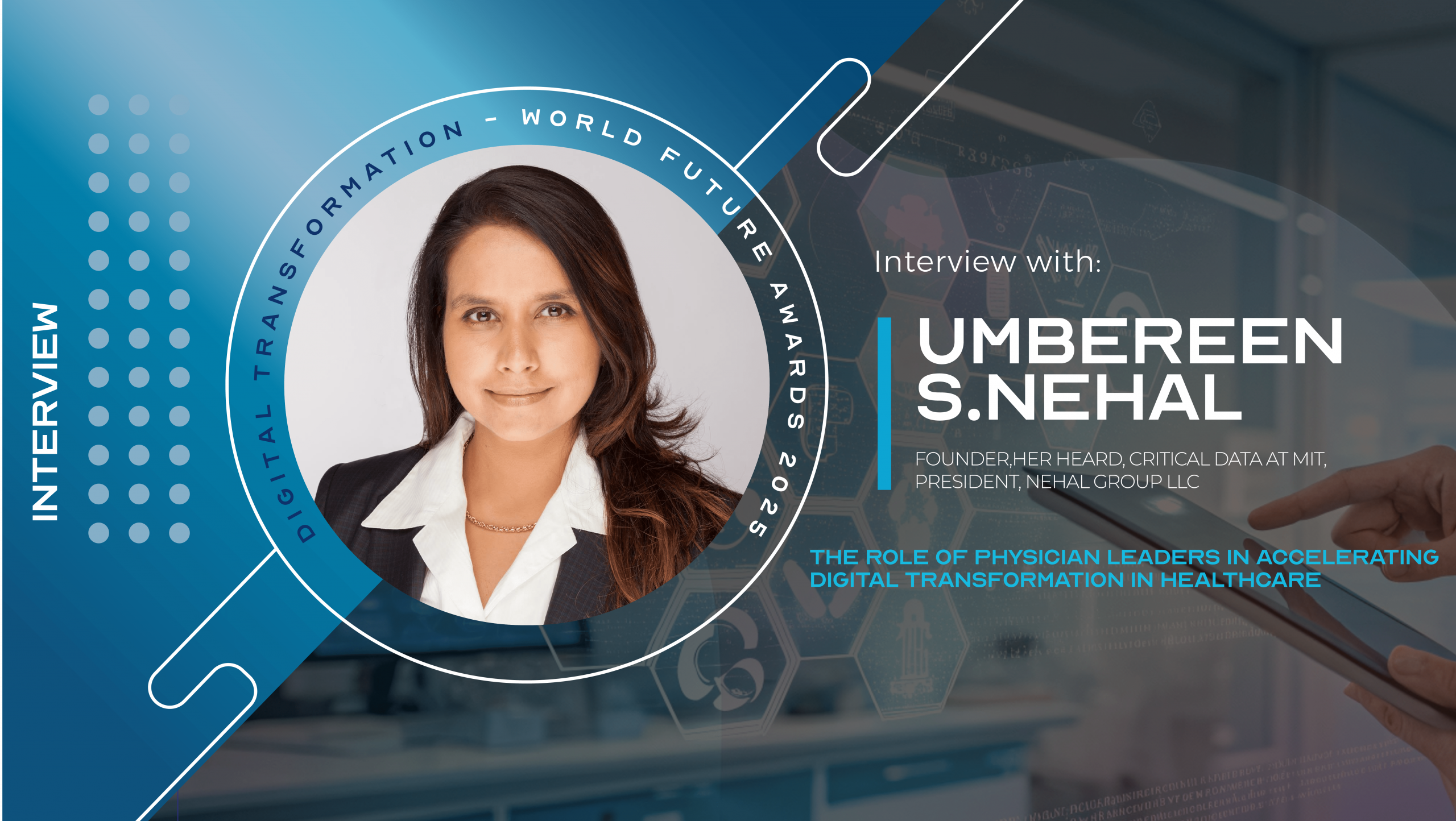
The Role of Physician Leaders in Accelerating Digital Transformation in Healthcare: An Exclusive Interview with Dr. Umbereen S. Nehal
In a time where healthcare and technology are converging at an unprecedented pace, visionary leadership is essential to drive transformation that is not only innovative but also inclusive. Dr. Umbereen S. Nehal exemplifies this rare combination of clinical expertise and technological foresight. A seasoned physician executive and founder of a digital health venture incubated at MIT, Dr. Nehal has been at the forefront of aligning digital innovation with frontline realities, advancing personalized, equitable, and system-wide healthcare solutions.
World Future Awards is honored to feature Dr. Nehal in this exclusive interview exploring The Role of Physician Leaders in Accelerating Digital Transformation in Healthcare. With a unique perspective shaped by her leadership across government, industry, and care delivery, Dr. Nehal brings deep insight into how data-driven, human-centered innovation can reshape the future of global health, especially in the U.S., where she has had her greatest impact.
Questions:
World Future Awards: You bring a rare dual lens as both a physician and a tech executive. How has this combined perspective shaped your approach to digital transformation in healthcare?
Dr. Umbereen S. Nehal: When done right, both clinical care and digital innovation serve the human end user, either as patient-centered clinical care or user-centered design of tech. I am not trying to “disrupt” or add more fragmentation; mine is a systems thinking approach. As a frontline physician, I experienced cumbersome tech that turned me into a data entry clerk. Frustrated that it took my focus away from what my patient needed, I became a “super user” to improve my own work. Now I do that at scale as a digital health founder. We need more coordination and efficiency so that tech can do mundane tasks so we can reduce clinician burnout and bring humanity back into healthcare.
WFA: What are the most critical areas of opportunity for physician leaders to accelerate digital transformation while maintaining clinical integrity and improving outcomes?
USN: I would advise physicians to engage as advisors, co-designers, or even founders. No one knows the pain points, needs, or workflows of healthcare better than practicing clinicians like doctors, nurses, pharmacists, etc. Physicians have been sold (or even mandated to buy) so much bad technology over the years that many are understandably sceptical of the latest promises on health tech. Sometimes doctors get described as “resistant” or “luddite.” I would take more of a driver’s seat. Learn some basics. Have the ability to ask smart, incisive, probing questions about tech. This is something that I have been developing a course on, in fact. Most conferences are now offering sessions on AI so any physicians can learn what is most critical for their field or clinical setting.
WFA: Your current venture, incubated at MIT, addresses a core pain point in clinical care—limited time during doctor visits. What inspired this focus, and how is your AI-enabled solution improving that experience for both patients and physicians?
USN: While at MIT, I founded HER Heard based on my own patient experience of fragmented care, late diagnosis, and delays in getting care. I also saw how my stoic, dignified mother often got ignored by nurses and doctors compared to louder, more demanding patients. I do not think women need to “speak up” more; instead, the system needs to listen better. I think of it like how a queen is surrounded by those serving her, anticipating her needs. With AI agents, we can make that possible for the average woman, too.
Specifically, we have created a structured, pre-visit process that captures the nuance of the patient’s story and lived experience that fits into the healthcare system. We’re using AI as an interface and analysis tool for collecting, organizing, and synthesizing patient-reported data—symptoms, goals, concerns, and values. The system prepares the patient for the visit with education and prompts, while giving the clinician a summary that aligns both with their workflow and what insurance wants documented. Our platform and AI pre-visit medical assistant is built on best practices from AHRQ (Agency for Health Research and Quality), like Shared Decision Making (SDM). We’ve embedded patient-reported outcomes and quality-of-life measures because those are the metrics that matter for patients and are research-grade data.
WFA: You’ve played leadership roles in public health, Medicaid reform, and digital health innovation. How do you connect government, industry, and clinical practice to design inclusive, data-driven health systems?
USN: From my various roles, I see the importance of data portability, ownership, and control over one’s own health data as a patient. As an advisor to federal agencies like the NIH, I have been involved in the community recruitment for the All of Us database, for instance. I am excited by what researchers can do with that data. For the average woman, though, she still struggles to access her own data for her own health in a way that informs her day-to-day health. From my work at a state and local level, I know the health landscape well. I don’t duplicate what exists but build according to the unmet needs. That allows me to tap into underserviced markets to bring more people along for digital health, reducing the digital divide.
WFA: “Equity by design” is a central theme in your work. Can you share how you ensure that inclusivity and health equity are embedded into digital health solutions from the start?
USN: Most digital tools start by empathy mapping for a primary user, usually the most tech-savvy. Designing for the ideal user can be efficient from a product standpoint, but it completely misses the complexity of healthcare realities. At HER Heard, we apply principles from universal design. We intentionally design for people called “the extreme user” who experience more challenges. Consider the woman working two jobs who also cares for aging parents – she has limited time, energy, and attention span, so she needs highly engaging and tailored UI/UX. We also think of family systems and community supports, not just one individual user at a time. Because women make 80% of healthcare decisions for their families, it is often said that a woman is the “Chief Medical Officer” of her family. In this way, we also strengthen the business model. Where a woman seeks care, her children, spouse, and parents may also go.
WFA: As a former Chief Medical Officer for 14 centers and co-author of a $1.8B Medicaid reform initiative, what lessons have you learned about operationalizing innovation in large-scale systems?
USN: At the state level, that $1.8B Medicaid transformation required enabling data transfer between a range of hospitals and several government agencies (Medicaid, Department of Public Health, CMS, etc). From that, I got into the weeds of data infrastructure and definitions needed for interoperability. It was a crash course in how legacy systems were not built with a future focus. Then, as the Chief Medical Officer managing a $100 million budget, I found that many vendors wanted to sell to us, even though their products were not built for our population.
This is the classic “build versus buy” dilemma. I recommend a hybrid approach: be a pilot site to co-design the innovation to suit your organization’s unique needs. I learned this best when I had oversight of a $300 million research budget for PCORI (Patient-Centered Outcomes Research Institute), where all our studies were co-designed and co-administered with community partners for true grassroots innovation.
WFA: What role do you see human-centered design and personalized medicine playing in the future of healthcare, especially when powered by AI and big data analytics?
USN: Patient-generated data from wearables or symptom diaries may be able to fill in gaps in research and make personalized medicine more accessible. If genomics is added in, the precision increases. With HER Heard, for instance, the primary goal is to serve individual women with personalized health. In addition, by designing to record research-grade data, we will create a valuable data lake over the years. If patients opt in to participating in research, the pooled data can help us better understand women’s health overall.
In tech, the term “GIGO” or garbage in, garbage out is used to describe bad data giving bad analyses. We can only get personalized medicine that works for everyone if we have the right data. For instance, women were not included in clinical trials until 1993. That means the textbooks used to teach doctors and nurses are wrong. Even many of the so-called “evidence-based guidelines” are incorrect.
Once we have better data that is more representative across all of humanity, we can offer better personalized healthcare. In order to get there, we do need everyone engaged. Privacy, understandably, is a concern for many. I am hopeful that decentralized AI will allow more data to stay secure on individual devices while only the key insights are shared. Personalized medicine is not just the clinical care being personalized, but even the level of data privacy itself being personalized. We are moving away from centralized data on servers or a cloud and towards individual choice.
Thank you, Dr. Nehal, for sharing your time, insights, and visionary perspective—your work at the intersection of medicine, technology, and equity is truly inspiring and essential to the future of healthcare.
Visit Dr. Nehal’s LinkedIn profile to learn more: https://www.linkedin.com/in/usnehal/
MORE NEWS

The 2025 Tech Christmas List: 11 Gifts for Forward Thinkers

BitFuFu Named Among World Future Awards’ TOP 100 Next Generation Companies

Next Generation Companies 2025

The Future of Learning is Hybrid, Tech-Enhanced & Human-Centric – Interview with Dora Hrkac, WFA Board Member

Connected Futures: The Rise of Smart Homes

Driving Global Change Through Marketing Intelligence: An Interview with Tonia Maneta of Bizzdesign

Beyond Borders: The New Era of Remote Learning and Global Education Access
NEWSLETTER
Sign up to learn more about our project and to stay up to date.

